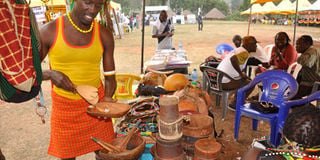Prime
Culture fair: Selling Uganda’s rich heritage

A participant shows off the Karimojong culture in the cultural fair last year. Photo by Stephen Otage
What you need to know:
- Heritage: Culture is at the core of every community. It shapes perspectives and ways of life and Uganda can use this to its advantage.
We may want to agree with Winston Churchill, on Uganda being the Pearl of Africa. A friend who visited from US said almost the same words; ‘though I leave, my heart has remained in Uganda’. This beauty stretches far beyond the weather, the wildlife, and landscape; it is deep within our roots – our culture.
Every ethnic group of the 65 indigenous communities comes packaged in its own way, from the way of dressing, language, food and arts. To explore and showcase that uniqueness and diversity as backbone to creating cultural tourism, the ministry of Tourism, wildlife and Antiquities working together with the ministry of Gender Labor and social development, KCCA and Perfect events, last Tuesday launched the second annual Uganda International cultural fair.
It will take place from July 28 to July 30 at the Uganda Museum under the theme, ‘Cultures Empowering each other.’
From the heart
“Culture begins at the heart of family. Language, behaviour, and other aspects of culture begin at home. Therefore, thinking that not knowing one’s culture is being modern and civilized, is actually the reverse,” declared Godfrey Kiwanda, state minister for tourism during the launch.
But with culture so diverse, and a world changing so fast, there is always a constant need to reinforce these heterogeneous cultural aspects.
Strength in diversity
The Karamojong community in North Eastern Uganda is popular for cattle keeping, colourful traditional dress that comprises beads, bright blankets and short shirts made of hides. In the East, the Bamasaba people stand out for their embalu (male circumcision) ceremony that marks the initiation rite of boys into men. The Kadodi dance is a spectacle to behold.
In the West are Bantu groups such Banyankore, Bakiga, Batooro. The latter are renowned for their ‘Empaako’ naming culture where all newborns are given culturally prestigious names atop their ordinary names. The male can go by names like; Araali, Abaala, Achaali, Apuuli and others like; Atwooki, Abwooli, Amooti can be used by both men and women.
The biggest ethnic group in the Central region, the Baganda strongly practice the clan system. These are just a few examples of the rich heritage that Uganda has to offer.
Preserving our roots
United Nations Educational, Scientific and Cultural Organisation (UNESCO) held a capacity building convention on the protection and promotion of the diversity of Cultural Expressions in October last year, as another way of appreciating Uganda’s cultural diversity. UNESCO also protects some cultural sites, like the museums and royal Tombs.
Uganda continues to promote its culture through; selling art and craft, for example, in the African Art and craft villages in different parts of the country, music dance and drama is performed by cultural troupes such Nderere Cultural Troupe, Afri- performers, Kika Troupe, Crane performers. At different tourism sites, crafts and cultural depictions are also exhibited.
According to Yusuf Kaddu of Kika Troupe, previously, the concept of culture was not well understood across age. Whereas the elderly held it close to heart, the youth considered it backward. “As people who sell culture, there was a need for us to rebrand culture,” Kaddu says, recommending using channels that appeal to the youth like music.
Songs like Namusanga Ndeeba by Bobiwine, Njogereza by Navio with a touch of cultural dances and drums have become popular among youth. “For our foreign audiences, being professional and presenting our culture with a touch of class has been essential.
Presenting culture to high profile audiences requires a degree of professionalism from the costumes to the songs and performance. We rebrand it to suit such people, and they certainly appreciate our culture,” Kaddu continues.
Ugandan artistes have recently adapted a new genre of music that blends Bakisimba cultural drums of the Baganda and Ragga tunes called Baks- Ragga. Such moves promote culture.
The cultural fair
The cultural fairs are meant to bring all the different ethnic aspects of the Ugandan society together at one venue. Former exhibitors like Aisha Kariuki, a member of the Nubian community use it as an opportunity to promote their culture and also earn a living.
“We got to interact with fellow crafts makers and share ideas. But it was also ground for exposure of our products, especially people like us with small businesses,” she says. Karuiki was part of the Bombo Nubian Mini Cultural Center, who trade in Nubian crafts like baskets and mats. The three day fair which had more than 214 exhibitors attracted 10,000 visitors, 40 percent from the foreign community.
According to Florence Nakiwala, State minister for Youth, the upcoming fair will be an opportunity to showcase Uganda’s culture from all parts of the country to the international community, develop innovative skills, build communities powerful enough to use their cultural settings to better themselves but also strengthen unity in diversity. Besides the exhibitions, conversations on conservation of natural resources and how culture relates to peace, family and finances will be at the forefront.




